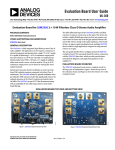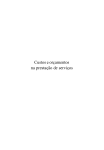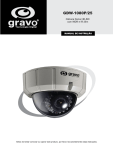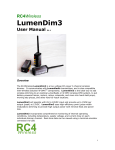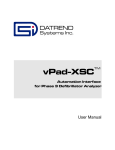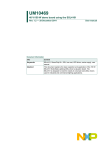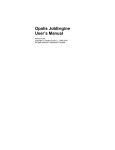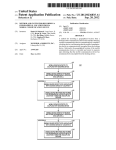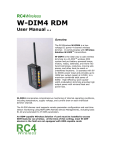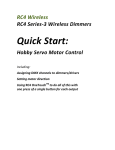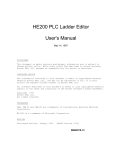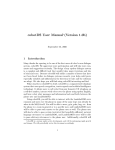Download DCshow64 User Manual R1.0
Transcript
Soundsculpture Incorporated DCshow64 DMX Controlled 64‐Channel 8V – 24VDC Motor Controller User Manual DCshow64 User Manual Rev 1.0 PRELIM © 2010 James David Smith & Soundsculpture Incorporated All Rights Reserved Table of Contents Overview .......................................................................................................................................... 4 Getting Started – Setting Up the Rack Unit ..................................................................................... 5 Driver Card Front Panel Switches and Indicators ............................................................................ 8 Getting Started – Using DCshow64 Config Software ...................................................................... 9 Rear Panel Connection Diagram – All Card Types ......................................................................... 17 DMX Input Card – Architectural Details ........................................................................................ 18 UNIDIR4 and BIDIR4 LED Indicator Legend ................................................................................... 19 UNIDIR4 Card – Architectural Details ............................................................................................ 20 UNIDIR4 Card – Limit Switch Input Schematic .............................................................................. 21 UNIDIR4 Card – Limit Switch Input PCB Diagram .......................................................................... 22 BIDIR4 Card – Architectural Details ............................................................................................... 23 BIDIR4 Card – Limit Switch Input Schematic ................................................................................. 24 BIDIR4 Card – Limit Switch Input PCB Diagram ............................................................................. 25 Technical Support / Contact Information ...................................................................................... 26 Overview The Soundsculpture DCshow64 provides 64 DMX‐controlled low‐voltage power drivers intended for motors, lamps, LEDs, solenoids, relays, and most other electrical load devices. Limit switch inputs for each driver facilitate end‐of‐travel shut‐offs without the need for high‐current inline switches. The DCshow64 is ideal for parade floats, mobile theatrical set pieces, animatronic characters, and more. Input voltage can be anything from 8V to 24VDC; 12V or 24V battery arrays are most typical. A 5U rack chassis provides card slots for one master controller card, and 16 power driver cards. The standard master controller card provides an optically‐isolated DMX data input, and USB port for configuration of driver cards via PC software. Two different driver card types are available: the UNIDIR4 quad unidirectional driver, and the BIDIR4 quad bidirectional driver. Each power driver can be assigned to any DMX control channel. In addition, a global‐enable DMX channel is used to enable/disable all drivers on a card, and is usually the same channel for all cards in a rack. Power is delivered via 17KHz pulse‐width‐modulation (PWM) for silent operation, with either a linear, inverse‐square‐law (ISL), or non‐dim power curve. Each driver is protected with built‐in over‐current and over‐temperature shutdown, and the over‐current threshold is user adjustable for each individual driver. The UNIDIR4 works much like a 4‐channel dimmer card. Each of the four drivers can deliver more than 10A continuous. This card is ideal for lighting, motors that only need to run in one direction, solenoids, relays, air brakes, and more. The BIDIR4 card provides four 10A H‐bridge drivers, suitable for running DC motors in either direction, fully reversible. Regenerative deceleration ensures fast motor responsiveness. The user can select from several different operational modes for each driver, including one‐ and two‐channel motor control. Energy‐saving thermal management ensures quiet operation. A network of cooling fans is engaging only when required to remove excess heat from the chassis. In the event of an over‐current shutdown or blown fuse, a rapidly blinking LED quickly draws the eye to the source of the problem. All control parameters are configured using DCshow64 Config software on a PC, connected to the rack unit via USB. From the software, any driver card can be selected. Parameters applicable to that card are displayed for adjustment, and can be edited and sent back to the card with ease. Configuration data is stored on the card in non‐volatile flash memory. Getting Started – Setting Up the Rack Unit The DCshow64 is preconfigured for easy testing right out of the box. Simply connect a battery or other DC power supply, a source of DMX control data, and one or more load devices – any combination of lamps, motors, etc. Each output driver has a RUN/OFF/TEST switch. Switch a driver to TEST to send power to the connected load at a level of 75%. If the load exceeds the shut‐down current limit, the driver will turn off and the blue status LED for that driver will rapidly blink. Switch the toggle to OFF to reset. Refer to software instructions later in this manual to learn how to change the current limit setting for each driver. To operate a driver with DMX data, move the toggle switch to RUN. Initially, all driver cards are configured to use the first five DMX channels. Channel 1 is the global enable channel and must be above 67% for any drivers to operate. The four drivers of each card are assigned to channels 2, 3, 4, and 5. Refer to software instructions later in this manual to learn how to change the DMX channel assignments for each driver of each card. DC Power Input (Batteries) INCOMING POWER MUST BE EXTERNALLY FUSED/CURRENT‐LIMITED TO A MAXIMUM OF 175A PER INPUT CONNECTOR. THIS IS THE MAXIMUM RATING OF EACH ANDERSON 6325G1 POWER CONNECTOR. Connect a source of DC power to one or both of the 6325G1 DC inputs on the back of the rack. Note that each input provides power to 8 driver card slots. To use all 16 slots, power must be supplied to both DC input connectors. DC Power Outputs (Loads) A yellow/grey pair of Anderson Powerpole connections provides power output for each DCshow64 driver. Detailed pin‐out diagrams are provided later in this manual. For unidirectional UNIDIR4 cards, the yellow connection is always positive, and the grey connection is pulse‐width‐modulated (PWM) negative at 17KHz. Thus, these drivers are common‐positive. For bidirectional BIDIR4 cards, both connections for each driver are PWM modulated and can swing both positive and negative. When a driver is enabled with a control level of zero, power is active with alternating polarity at a level of 50% to hold the motor in a stationary position. Changing the control level changes the alternating duty cycle: above 50% spins the motor clockwise; below 50% spins the motor counter‐clockwise. This technique provides very responsive tracking of motor shaft speed to control level, since the motor is always powered and never coasting. The bidirectional driver only turns off when the DMX enable channel is off, or the RUN/OFF/TEST toggle switch is set to OFF, or an over‐current fault has occurred. Limit Switch Inputs Each power driver provides one or more limit switch inputs. These inputs are active low, meaning they cause an action when they are pulled to ground. These inputs have internal pull‐ up resistors; when not needed, they can be left open. For ease of wiring, ground pins are provided on the limit switch input terminals. Detailed pin‐out diagrams are provided later in this manual. Each driver on the UNIDIR4 driver card has a single limit switch input. When active (pulled low) , the associated output is turned off. Each driver on the BIDIR4 driver card has two limit switch inputs – one for clockwise operation, the other for counter‐clockwise motion. This allows a shut‐off to occur when the motor is moving one way, but still allow the motor to operate the other way and back out. When it is desired that a single switch stop the motor, regardless of direction, the two limit switch inputs can be connected together. When a limit switch input is active (pulled low), the associated driver immediately generates active hold power to decelerate the motor as quickly as possible. DMX Data Input The DCshow64 DMX input complies with USITT DMX512/1990 (4us), and is optically isolated. DMX pin‐1 ground in no way connects to power or chassis ground within the rack unit. Thus, substantial ground differential between the DMX data source and local DC power will have no affect on performance. USB Configuration Data Connection The USB port on the DCshow64 rack unit interfaces to a PC running DCshow64 Config software. This port utilizes an FTDI interface chip that appears as a COM port in the Windows operating system. When first connecting this port, allow Windows to search the Internet for the required drivers and they will install automatically. If you do not have Internet access, drivers are also provided on the DCshow64 software CD. Future Expansion and Custom Options The modular design of the DCshow64 can support other types of master and driver cards. For example, master controller cards could be developed for DMX record/playback, MIDI Show Control input, or support of other control protocols. Driver cards could be developed for servo positioning with rotary‐encoder and/or potentiometer positional feedback, higher power handling, control‐voltage (CV) outputs, pulse outputs for hobby servos, and much more. Custom driver cards can be developed for specific projects and applications. Contact Soundsculpture Incorporated for additional information. Driver Card Front Panel Switches and Indicators Fuse ‐ All DCshow64 driver cards feature electronic over‐current and over‐ temperature protection. In the event that these features fail, overall safety is ensured with a physical fuse. This fuse value should not exceed 40A. Status LEDs – Each individual driver features a three LED indicators. The top LED in each group indicates driver output power. It is directly connected to the output connectors on the back of the card. On a unidirectional UNDIR4 card, it is yellow. On a bidirectional BIDIR4 card, it is red/green bicolor; red and green mix to appear yellow when the motor is stopped. The middle blue LED in each group is the channel status indicator. When solidly lit, the channel is active and in RUN mode. When slowly blinking, the channel is active and in TEST mode. When rapidly blinking, the channel is disabled by an over‐current fault. The green LED at the bottom of each group is a system function or status indicator and is not driver specific. The top green LED is the COP (computer operating properly) indicator. It slowly blinks with a short duty cycle to show that internal firmware is running. The second green LED from the top indicates valid incoming DMX data. The third green LED from the top indicates the state of the DMX Enable Channel. This channel must be high, and the indicator must be on, for any of the drivers on the card to operate. The bottom green LED indicates that incoming DC power is good, and the fuse is good. If power supply fault occurs (including a blown fuse), this LED will blink rapidly. Toggle Switch – Each individual driver features a toggle switch with three positions. Up = RUN, Center = OFF, and Down = TEST. When the channel is disabled by an over‐current fault, it can be reset by moving the toggle to the OFF position, then back to the desired setting. Getting Started – Using DCshow64 Config Software All driver configuration and setup is done from a PC, using DCshow64 Config software. This software has been authored using Microsoft Visual Studio 2005, and requires .NET Framework 2.0. Comprehensive software testing has been done only with Windows XP with SP3. Nonetheless, we expect this application to function appropriately in Windows 2000, Windows XP, Windows Vista, and Windows 7. USB Port Drivers The USB port on the DCshow64 utilizes an FTDI interface chip, part number FT232R. Drivers for this chip are available through Windows Update. Where an Internet connection is available, allow Windows to find, download, and install the required driver. This process is entirely automatic , and takes place the first time the DCshow64 is attached via USB cable and powered on. If and Internet connection is not available, the driver is also provided on the DCshow64 CD. Additional USB port and driver support is available from the FTDI website at http://www.ftdichip.com/Drivers/VCP.htm. FTDI driver installation guides, including troubleshooting information, are available at: http://www.ftdichip.com/Documents/InstallGuides.htm DCshow64 Config Program Installation The DCshow64 Config Installer is provided on the DCshow64 CD, or can be downloaded from the technical support website at http://www.theatrewireless.com/DCshow64. Unpack the contents of the .zip file, and run setup.exe. When installation is complete, an icon for DCshow64 Config will appear on the Windows desktop, and a new folder will be added to Start Menu ‐> All Programs. This folder is called Soundsculpture Inc., and contains links to the program and online technical support. Launch the DCshow64 Config program by double‐clicking the program icon on the desktop, or selecting it from Start Menu ‐> All Program ‐> Soundsculpture Inc. ‐> DCshow64 Config. Running the DCshow64 Config Application Before launching the program, be sure the DCshow64 rack unit is powered on, the USB port is connected to the PC, and the USB drivers have been installed. When you first launch the program, it has not yet communicated with the rack unit. Thus, only basic communication functions are visible: A list of available COM ports appears at the top left. If you have multiple COM devices installed on your PC, they will all appear on the Select Port list. In many cases, however, the only device in the list will be the DCshow64 rack unit. All ports are listed by COM port number – i.e. COM1, COM7, COM11, etc. Click the COM port that represents the connection to the rack unit. The com port status message below the selection list should change from Port is Closed to Port is Open. You can now select a specific card within the rack unit by clicking on card number in the Select Card list – i.e. Card 1, Card 2, … Card 16. When a card selection is made, that card is queried for setup information. If it responds with valid data, the software window is filled in with applicable parameters for that card: Debug Lines The two long text boxes at the bottom of the DCshow64 Config program window provide debugging and diagnostics information. The upper line displays numeric data sent out to cards in the rack unit; the lower line displays numeric data returned from the rack unit. Non‐critical status warnings and messages are also displayed on this lines. (Critical usually invoke a message box and require the user to acknowledge by clicking Ok.) Software Data Panels When a card is selected, various data panels appear. All driver card types utilize a Global Card Settings panel, a Status panel, and one or more Output panels. The Status panel displays only information returned from the driver card. All other panels provide access to user configurable settings. The UNIDIR4 and BIDIR4 driver cards both provide four output panels, one for each available power driver. Because these two different card types are very similar, they share the same software display routines. Some parameters for the BIDIR4 card are not supported by the UNIDIR4 card, and are disabled (greyed out) when a UNIDIR4 card is selected. Global Card Settings Two global parameters are currently provided: DMX Enable Channel This DMX channel must be on (above 67%) to enable power output on the driver card. When this channel is off, no drivers are enabled. In most cases, the same Enable Channel will be used for all cards in a rack unit, providing a simple way to quickly disable all outputs on all cards at once. Damping Time This parameter determines how quickly channel levels can change. This is particularly important when driving large motors that require time to safely slow down and reverse. When first setting up a motor application, it is recommended to use a slow damping time until all other parameters are set and the control system is working as expected. Accidental sudden changes in motor direction and/or speed can strain drivers, motors, and connected mechanical systems – a slow damping time minimizes this strain. Once everything is programmed and running properly, reduce the damping time for quicker, tighter movements. The range of power deliverable to a motor can be plotted on a line. The control signal for a motor control can seen as a pointer along this line: Full Speed CCW ‐‐‐‐‐‐‐‐‐‐‐‐‐‐‐‐‐‐‐‐‐‐‐‐‐‐‐‐‐‐‐‐ STOPPED ‐‐‐‐‐‐‐‐‐‐‐‐‐‐‐‐‐‐‐‐‐‐‐‐‐‐‐‐‐‐‐‐‐‐‐‐‐‐‐‐ Full Speed CW ^ | Control pointer to the stopped position. Damping Time determines how quickly the pointer can move across this line. If the motor is currently running full speed ccw, and the control signal suddenly changes to full speed cw, damping time forces the pointer to move smoothly across the range: decelerating ccw, stopping, then gently accelerating cw. This action always occurs in DCshow64 drivers, but it happens very quickly when the damping time is fast. Although the example above applies to bidirectional drivers like those in the BIDIR4 card, Damping Time is also employed on unidirectional cards. It is sometimes less noticeable because unidirectional cards do not employ regenerative deceleration techniques; the load coasts as power is reduced. Nonetheless, higher damping times reduce surges and strains during acceleration. Status Several status values are reported by all cards, regardless of type. In addition to these, each card type also supports status values that are unique to them. The common values are: Card Type Indicates the type of card assigned to the selected Card Number , i.e. UNIDIR4, or BIDIR4. Firmware Version Indicates the version of firmware installed in the selected card, i.e. f/w Version 1.2. Voltage Indicates the input voltage to the rack. Current and Temperature Indicates the current draw in Amps and temperature in degrees (usually Fahrenheit) for one or more drivers on the selected card. Both the UNIDIR4 and BIDIR4 provide 4 readings – amperage and temperature for each of the four available driver. Output x Both UNIDIR4 and BIDIR4 cards provide four output windows, one for each power driver on the card: Output 1, Output 2, Output 3, and Output 4. Each of these windows provide identical parameters. The parameters available for each card type are described in the next section of this manual. UNIDIR4 Output Parameters DMX Level Channel Power driver output level can be controlled from any DMX channel, range 1 – 512. A channel number can be directly typed in, or selected with the up/down arrows. Power Curve DMX control channels provide a range, or resolution, of 256 steps. A level of 0 (zero) is off, up to the maximum level of 255. This range is represented by an 8‐bit byte in the DMX data stream. Many DMX consoles and controllers are programmed in percentage increments. In this case, a channel at 100% represents a level of 255. Internally, the power drivers in the DCshow64 have 2550 steps from 0% to 100%. This relatively high resolution makes it easy to map different response curves across the range. Three power curves are available: Linear The linear power curve is most common, and is suitable for incandescent lamps and motors. With this curve, each increment of the DMX channel represents 10 increments of the motor driver output. Thus, a 50% DMX level (127/255) delivers a 50% duty cycle at the DCshow64 power output (1270/2550). Inverse Square law (ISL) LEDs do not emit visible light linearly, relative to driver power delivered. When they are driven linearly, they appear to dim up quickly at the bottom of the dimmer curve; brightness then varies little for the rest of the range. The Inverse‐Square‐Law curve provides visually linear dimming for LEDs and other similar devices. Non‐Dim When driving relays, solenoids, and other on/off devices, the non‐dim curve provides cleanly switched power with no PWM component. Current Limit Each DCshow64 power driver incorporates a current sensor that is digitally sampled at high speed. Firmware (on‐board software) emulates a circuit‐breaker, by disabling the driver of current measurements exceed a specified threshold. The driver can be reset by moving the front panel toggle switch to the center OFF position, then returning it to the desired mode (RUN, or TEST). The over‐current threshold is user‐selectable in 2A increments from 6A to 18A. An over‐current condition is indicated on the front panel with a rapidly blinking channel status indicator (blue LED). BIDIR4 Output Parameters This chart illustrates how the BIDIR4 power driver operates, internally: Full Speed CCW ‐‐‐‐‐‐‐‐‐‐‐‐‐‐‐‐‐‐‐‐‐‐‐‐‐‐‐‐‐‐‐‐ STOPPED ‐‐‐‐‐‐‐‐‐‐‐‐‐‐‐‐‐‐‐‐‐‐‐‐‐‐‐‐‐‐‐‐‐‐‐‐‐‐‐‐ Full Speed CW ^ | control pointer to the stopped position. DMX Level Channel Power driver output level can be controlled from any DMX channel, range 1 – 512. A channel number can be directly typed in, or selected with the up/down arrows. This channel determines the position of the control pointer. Driver Mode Four power driver modes are provided, and are user selectable: Fixed CW This mode emulates a unidirectional driver , clockwise polarity, with the added advantage of regenerative deceleration, which is not available on the UNIDIR4 card. The control pointer range is limited to the right side of the control chart above. Fixed CCW This mode emulates a unidirectional driver , counter‐clockwise polarity, with the added advantage of regenerative deceleration, which is not available on the UNIDIR4 card. The control pointer range is limited to the left side of the control chart above. Bidir1 Center Off This mode directly maps the DMX Level Channel to the control pointer. Thus, the DMX channel must be in the center position (50%, or 127/255) for the motor to be stopped. Bidir2 2 DMX Channels This mode provides real‐time switching between CW and CCW modes. The DMX Direction Channel (detailed below) selects direction. In this mode, the setting of Damping Time is most important, to avoid severe system strain of the direction channel is changed while the level channel is high. DMX Direction Channel When using the Bidir2 2 DMX Channels motor control mode, motor direction can be controlled from any DMX channel, range 1 – 512. A channel number can be directly typed in, or selected with the up/down arrows. The range of the direction channel is divided into three segments. The bottom third, from 0% to 34%, selects CCW operation. The center third, from 34% to 65%, stops the motor, and the top third, from 66% to 100%, selects CW operation. Power Curve DMX control channels provide a range, or resolution, of 256 steps. A level of 0 (zero) is off, up to the maximum level of 255. This range is represented by an 8‐bit byte in the DMX data stream. Many DMX consoles and controllers are programmed in percentage increments. In this case, a channel at 100% represents a level of 255. Internally, the power drivers in the DCshow64 have 2550 steps from 0% to 100%. This relatively high resolution makes it easy to map different response curves across the range. Three power curves are available: Linear The linear power curve is most common, and is suitable for incandescent lamps and motors. With this curve, each increment of the DMX channel represents 10 increments of the motor driver output. Thus, a 50% DMX level (127/255) delivers a 50% duty cycle at the DCshow64 power output (1270/2550). Inverse Square law (ISL) LEDs do not emit visible light linearly, relative to driver power delivered. When they are driven linearly, they appear to dim up quickly at the bottom of the dimmer curve; brightness then varies little for the rest of the range. The Inverse‐Square‐Law curve provides visually linear dimming for LEDs and other similar devices. The ISL curve is available ONLY in Fixed CW and fixed CCW modes. On all other modes, a linear curve is used, regardless of the Power Curve setting. Non‐Dim When driving relays, solenoids, and other on/off devices, the non‐dim curve provides cleanly switched power with no PWM component. Current Limit Each DCshow64 power driver incorporates a current sensor that is digitally sampled at high speed. Firmware (on‐board software) emulates a circuit‐breaker, by disabling the driver of current measurements exceed a specified threshold. The driver can be reset by moving the front panel toggle switch to the center OFF position, then returning it to the desired mode (RUN, or TEST). The over‐current threshold is user‐selectable in 2A increments from 6A to 18A. An over‐current condition is indicated on the front panel with a rapidly blinking channel status indicator (blue LED). Soundsculpture Incorporated DCshow64 - Rear Panel Connections QUAD BIDIRECTIONAL DRIVER CARD Outputs are 1 - 4 BOTTOM TO TOP YELLOW is output A, GRAY is output B Polarity reverses for CW / CCW drive. QUAD UNIDIRECTIONAL DRIVER CARD Outputs are 1 - 4 TOP TO BOTTOM YELLOW positive, GRAY pwm modulated negative. DMX IN / THROUGH Meets USITT DMX512 Specifications. Fully isolated DMX data souce may float +/-5000V. Data GND is not in any common with chassis/power GND. OUT 4 OUT 1 OUT 3 Male/Female XLR5 pins are directly connected straightthrough. OUT 2 OUT 2 OUT 3 OUT 1 OUT 4 UNIDIRECTIONAL LIMIT SWITCHES: Pin 1 (Ch1) Pin Pin Pin Pin Pin 8 1-2 3-4 5-6 7-8 Ch1 Ch2 Ch3 Ch4 Lim Lim Lim Lim Sw. Sw. Sw. Sw. Pin 1 (Ch1 CW) Pin 12 BIDIRECTIONAL LIMIT SWITCHES: Pin 1-3 Ch1 CW Lim Sw. Pin 2-3 Ch1 CCW Lim Sw. Pin 4-6 Ch2 CW Lim Sw. Pin 5-6 Ch2 CCW Lim Sw. Pin 7-9 Ch3 CW Lim Sw. Pin 8-9 Ch3 CCW Lim Sw. Pin 10-12 Ch4 CW Lim Sw. Pin 11-12 Ch4 CCW Lim Sw. USB CONFIG PORT Front and rear USB pins are directly connected straightthrough. Use either connector, but NOT both simultaneously. Port uses an FTDI interface chip. System drivers are available through Microsoft Update. Soundsculpture Incorporated DCshow64 - Master DMX Data Card Gold plated data contacts mate with gold plated receptacles on backplane. Slave cards communicate calls for heat, master card controls fans on backplane when needed. All communications on the internal bus are balanced RS485 for maximum noise immunity. DC-to-DC InductorBased Isolator for Power High-Speed Optical Isolators for Data USITT DMX512A compliant data inputs, optically isolated and fully floated, safe to 5000V differential. Power driver configuration is done via USB. A USB connection is provided on both from and rear, but ONLY ONE CONNECTION SHOULD BE USED AT A TIME (hey are wired in parallel). DCshow64 Driver Card LED Indicator Legend For Driver Card f/w 1.1 ON (solid) ____________________________________________ Rapid Blinking [ ]__[ ]__[ ]__[ ]__[ ]__[ ]__[ ]__ ]__[ ]__[ ]__[ ]__ Slow Blinking [ _ ]________ [ _ ]________ [ _ ]__ Each Channel Has Its Own Yellow and Blue Indicators: Yellow [ ] Power Output (directly connected to output terminals). Bidirectional cards use Red/Green bicolor LEDs to indicate polarity. A mix of red and green appears yellow/orange and represents a stopped motor. The color becomes more red as power increases cw, and becomes more green as power increases ccw. Blue Mode / Status OFF = channel is turned off (toggle switch in center) ON (solid) = RUN (dmx control engaged) Slow Blinking = TEST (manual run engaged) Rapid Blinking = overcurrent/overtemp trip, channel disabled (move toggle to off /center position to reset) [] Each Green LED is a Specific Global Indicator: Green [ ] COP (slow blink = all is well, microcontroller is running) Green [ ] DMX indicator (ON = good dmx present) Green [ ] DMX Enable Channel (ON = outputs are enabled) Green [ ] Voltage / Fuse Solid ON = fuse/input voltage are good rapid blinking = blown fuse At-a-Glance Summary: Normal operation will show the top green LED blinking slowly. Any rapid blinking indicates a fault of some sort. Soundsculpture Incorporated DCshow64 - Quad Unidirectional Motor Drive Gold plated data contacts mate with gold plated receptacles on backplane. High-current power is delivered through copper L-brackets that screw into the busbars (not shown). 40A fuse will open only if onboard electronic protection systems fail. All communications on the internal bus are balanced RS485 for maximum noise immunity. Anderson connectors for motor power outputs. Removeable screw-terminal block for limit switch inputs. Each driver has one limit switch input. State-of-the-art Microchip dsPIC33 Microcontroller includes an onboard DSP engine, multiple PWM generators and two highspeed data ports. Each of four N-Channel mosfet motor drivers has it’s own temperature and current sensor. The temperature sensor is positioned over copper in the current supply path to the mosfet. These sensors are the core of built-in circuit protection. 1 2 3 4 5 6 8 7 D D 5V R708 RMCF 1/8 10K 5% R IN_LIM0 R700 LIM0 RMCF 1/8 1.82K 1% R C700 CC1206KRX7R9BB104 5V R709 RMCF 1/8 10K 5% R LIM1 5V C701 CC1206KRX7R9BB104 4 6 RMCF 1/8 1.82K 1% R 5 IN_LIM1 R701 C C D700 QSBT40-7-F IN_LIM2 3 2 R712 RMCF 1/8 10K 5% R R702 1 5V LIM2 RMCF 1/8 1.82K 1% R C702 CC1206KRX7R9BB104 5V R713 RMCF 1/8 10K 5% R J700 LIM SW 0 LIM SW 1 LIM SW 2 LIM SW 3 LIM0 GND LIM1 GND LIM2 GND LIM3 GND J701 1 2 3 4 5 6 7 8 284506-8 IN_LIM3 1 2 3 4 5 6 7 8 R703 LIM3 RMCF 1/8 1.82K 1% R GND C703 CC1206KRX7R9BB104 GND GND GND 284512-8 B B Soundsculpture Incorporated 88 St. George St., Etobicoke, Ontario, Canada Toll Free 866-258-4577 www.theatrewireless.com Electronic hardware and software design by James David Smith DCshow64 - UNIDIRECTIONAL Driver Card - Limit Switch Inputs A Size A3 FCSM No. A DWG No. Scale Rev R3.0 Sheet 1 of 1 1 2 3 4 5 6 7 8 UNIDIR4 Card – Limit Switch Input PCB Diagram Soundsculpture Incorporated DCshow64 - Quad Bidirectional Motor Drive Gold plated data contacts mate with gold plated receptacles on backplane. High-current power is delivered through copper L-brackets that screw into the busbars (not shown). 40A fuse will open only if extensive on-board electronic protections fail. All communications on the internal bus are balanced RS485 for maximum noise immunity. Anderson connectors for motor power outputs. Removeable screw-terminal block for limit switch inputs. Each motor driver has two limit switch inputs, for cw and ccw limiting. State-of-the-art Microchip dsPIC33 Microcontroller includes an onboard DSP engine, multiple PWM generators and two highspeed data ports. Each of four H-bridge motor drivers has it’s own temperature and current sensor. The temperature sensor is positioned over copper in the current supply path to the power mosfets. These sensors are the core of electronic protection. 1 2 3 4 5 6 8 7 5V R708 RMCF 1/8 10K 5% R R700 IN_LIM0 LIM0 RMCF 1/8 1.82K 1% R D D C700 CC1206KRX7R9BB104 5V R709 RMCF 1/8 10K 5% R R701 LIM1 5V C701 CC1206KRX7R9BB104 4 6 RMCF 1/8 1.82K 1% R 5 IN_LIM1 D700 QSBT40-7-F 3 2 R712 RMCF 1/8 10K 5% R R702 IN_LIM2 1 5V LIM2 RMCF 1/8 1.82K 1% R C702 CC1206KRX7R9BB104 5V C C R713 RMCF 1/8 10K 5% R J700 LIM SW 0 LIM SW 1 LIM SW 2 LIM SW 3 CW CCW GND CW CCW GND CW CCW GND CW CCW GND 1 2 3 4 5 6 7 8 9 10 11 12 J701 1 2 3 4 5 6 7 8 9 10 11 12 R703 IN_LIM3 LIM3 RMCF 1/8 1.82K 1% R GND C703 CC1206KRX7R9BB104 GND 5V GND R718 RMCF 1/8 10K 5% R GND 1-284506-2 1-284512-2 R704 IN_LIM4 LIM4 RMCF 1/8 1.82K 1% R C704 CC1206KRX7R9BB104 5V R719 RMCF 1/8 10K 5% R R705 LIM5 5V 6 D701 QSBT40-7-F R706 3 2 R720 RMCF 1/8 10K 5% R 1 5V IN_LIM6 B C705 CC1206KRX7R9BB104 4 RMCF 1/8 1.82K 1% R 5 IN_LIM5 B LIM6 RMCF 1/8 1.82K 1% R C706 CC1206KRX7R9BB104 5V R723 RMCF 1/8 10K 5% R R707 IN_LIM7 Soundsculpture Incorporated 88 St. George St., Etobicoke, Ontario, Canada Toll Free 866-258-4577 www.theatrewireless.com Electronic hardware and software design by James David Smith LIM7 RMCF 1/8 1.82K 1% R C707 CC1206KRX7R9BB104 DCshow64 - BIDIRECTIONAL Driver Card - Limit Switch Inputs A Size A3 FCSM No. A DWG No. Scale Rev R3.0 Sheet 1 of 1 1 2 3 4 5 6 7 8 BIDIR4 Card – Limit Switch Input PCB Diagram Technical Support / Contact Information For online technical support, please visit http://www.theatrewireless.com/DCshow64/ or email [email protected]. Soundsculpture Incorporated can be reached toll‐free in North America at 866‐258‐4577, or at local number +1‐416‐259‐8499. Soundsculpture Incorporated (Toronto) 88 St. George St. (Near Islington & QEW) Etobicoke, ON, M8Z 3Y7 Canada


























